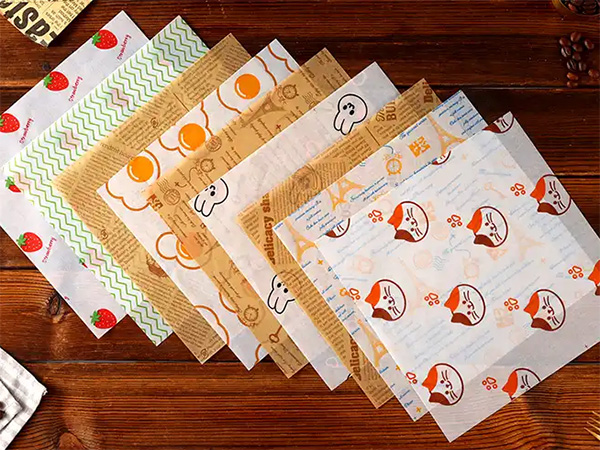Greaseproof Paper Custom refers to specialized paper that is engineered to possess specific properties tailored to unique industrial, commercial, or artistic requirements. Unlike standard Greaseproof Paper, which offers a basic barrier against oils and fats, custom variants are manufactured with precise control over parameters such as basis weight, porosity, tensile strength, and surface finish to meet the exact needs of a particular application. This customization is achieved through specialized pulping processes, refining techniques, and calendaring, resulting in a material with defined technical specifications for superior performance.

The primary characteristic of custom greaseproof paper is its exceptional oil and grease resistance, typically measured by the Kit Test value. Custom papers can be designed to achieve specific Kit ratings, often exceeding 12 (on a scale where 12 indicates high resistance), ensuring no visible grease penetration for extended periods, which can be critical for packaging high-fat content foods. Its low porosity and high density are quantified by Gurley densometer readings, which can be customized to fall within a range of 100 to 1000 seconds for 100 ml of air, creating a formidable barrier that prevents the migration of lipids. The material exhibits remarkable heat resistance, withstanding temperatures up to 220°C (428°F) without degrading, melting, or releasing harmful fumes, making it suitable for baking and cooking applications. Furthermore, custom grades offer controlled moisture resistance, with moisture vapor transmission rates (MVTR) that can be engineered as low as 15-20 g/m²/24h, protecting contents from both grease and ambient humidity. Despite its barrier properties, it maintains a degree of flexibility and foldability, with a tensile strength that can be specified from 4 kN/m to 10 kN/m in the machine direction, allowing it to be formed into various packaging shapes without cracking. Finally, as a cellulose-based product, high-quality custom greaseproof paper is often biodegradable and compostable, breaking down within 4 to 8 weeks in industrial composting conditions, aligning with sustainable packaging initiatives.
This is the most prevalent application. Custom greaseproof paper is used to line boxes for greasy foods like pizzas, burgers, pastries, and fried chicken. It prevents oil from soaking through the primary packaging, maintaining structural integrity and a clean appearance. Bakeries use it for interleaving between croissants and danishes, while butchers use it for wrapping fresh cuts of meat. Its heat resistance makes it ideal for pre-cut sheets for baking cookies and pastries.
Beyond the kitchen, custom greaseproof paper serves as a protective interleaving material between metal parts, precision components, or rubber sheets during storage and shipping to prevent corrosion or adhesion caused by oils and lubricants. Its dielectric properties make it suitable for use as an insulator in specific electrical components. In the pharmaceutical industry, it can be used as a liner for packaging certain types of ointments and creams.
Artists utilize custom-grade greaseproof paper for its unique texture and resistance to oil-based paints and mediums. It is employed in techniques like printmaking, particularly for protecting prints. In specialty printing, it can be used for creating labels for oily products or as a release paper for adhesive applications. The ability to customize its surface smoothness and opacity opens up creative possibilities.
A specific subset of custom greaseproof paper is butcher paper, engineered to be exceptionally strong and highly resistant to blood and moisture from fresh meat. Custom versions can be produced with controlled absorbency on one side to keep the meat's surface dry while providing a robust barrier on the other.
Proper care ensures that greaseproof paper, especially reusable or heavy-duty custom types, performs optimally and maintains its integrity.
Store greaseproof paper in a cool, dry place away from direct sunlight and heat sources. Ideal storage conditions are at a relative humidity of 45-55% and a temperature below 25°C (77°F). Exposure to excessive heat can cause the paper to become brittle, while high humidity can compromise its moisture resistance. Keep the paper flat or rolled as intended by the manufacturer to prevent creasing or curling, which could affect its performance in automated packaging machinery.
When using the paper for baking, ensure it is properly sized for the baking tray. Avoid direct contact with open flames or heating elements, as while it is heat-resistant, it is not flame-proof and will char or ignite if overheated. For packaging, handle the paper with clean, dry hands to prevent transferring skin oils or moisture onto the surface, which could potentially create weak spots for grease penetration.
Some heavy-duty, silicone-coated custom greaseproof papers are designed for limited reuse. If the manufacturer specifies reusability, gently wipe the surface with a soft cloth or sponge dampened with warm, soapy water. Do not soak or scrub abrasively, as this can damage the grease-resistant coating. Rinse thoroughly and allow it to air dry completely before storing or reusing. Do not use harsh chemicals or place it in a dishwasher unless explicitly stated as safe by the manufacturer.
Standard, uncoated cellulose-based greaseproof paper can typically be disposed of with organic waste or in home composting systems, as it is biodegradable. However, for custom papers, especially those with special coatings or laminations, it is crucial to consult the manufacturer's guidelines. Some custom papers may require disposal with general waste or specific recycling streams. Check for any relevant certifications (e.g., compostable logos) on the packaging for proper end-of-life handling.
Previous: What Is Wax Coated Paper ?